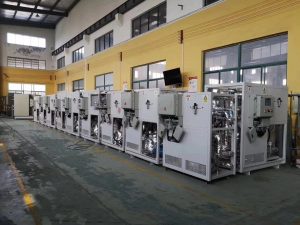Vantagens das bombas de circulação de baixa temperatura para laboratório

O circulador de baixa temperatura para laboratório pode fornecer simultaneamente temperatura constante e equipamento de refrigeração, aquecimento e controlo de temperatura. O circulador de baixa temperatura para laboratório tem uma estrutura razoável, um funcionamento simples e...
1. The laboratory low-temperature circulator uses a compressor for refrigeration, which consumes energy and improves the exhaust temperature. The refrigerant then exchanges heat with the surrounding medium under the right conditions, transferring the heat to the surroundings. If adiabatic expansion is carried out again, the temperature will decrease.
2. The laboratory low-temperature circulator absorbs isothermal heat from high-temperature objects through an evaporator to reduce the temperature of the object to be cooled. This cycle is continuously carried out to achieve the purpose of cooling. The design of the laboratory low-temperature circulator refrigeration system uses energy regulation technology. Effective treatment methods can not only ensure the normal operation of the refrigerator, effectively control the energy consumption and cooling capacity of the refrigeration system, reduce the operating cost of the experimental box refrigeration system, and achieve a more economical state.
3. The laboratory low-temperature circulator absorbs the heat of the object to be cooled from the evaporator and evaporates it with steam. The compressor continuously extracts the steam generated by the evaporator.
4. The high-temperature and high-pressure steam compressed by the laboratory low-temperature circulator is sent to the condenser, where the cooling medium (such as water, air, etc.) releases heat and condenses into a high-pressure liquid. The pressure is reduced through a throttling mechanism to enter the evaporator. Evaporate again, absorb the heat from the cooled object, and circulate in this way.
5. After the laboratory low-temperature circulator mechanism heats up, the refrigerant changes its flow through a four-way valve. The flow direction of the refrigerant is exactly opposite to the refrigeration process. The refrigerant first passes through the evaporator, then returns to the condenser, and then returns to the compressor.
Recomendações relacionadas
-
Vocs adsorption equipment refrigeration temperature control instructions
1646With the continuous improvement of environmental protection requirements, each factory has also concentrated the processing of vocs gas generated in production. LNEYA vocs adsorption equipment can process various vocs gases. So how much do you kno...
Ver detalhes -
Unidade de refrigeração a baixa temperatura na produção de materiais auxiliares do catalisador PGA
1257Os refrigeradores de baixa temperatura desempenham um papel importante no processo de reação de produção do ácido poliglicólico (PGA) e dos seus catalisadores e aditivos. O processo de síntese e pós-tratamento do ácido poliglicólico envolve frequentemente reacções exotérmicas, ...
Ver detalhes -
Resfriador de água para reator de polimerização de laboratório
1257O resfriador de água para reator de polimerização de laboratório é um dispositivo usado para controlar com precisão a temperatura dentro do reator, especialmente para reações de polimerização que precisam ser realizadas sob condições específicas de temperatura...
Ver detalhes -
Que tipo de refrigerador é necessário para a gravação a baixa temperatura?
1413The low-temperature etching process usually requires extremely high precision temperature control and strong cooling ability to maintain stable operation of the etching equipment at extremely low temperatures, in order to achieve finer etchi...
Ver detalhes
 LNEYA Refrigeradores industriais Fabricante Fornecedor
LNEYA Refrigeradores industriais Fabricante Fornecedor











